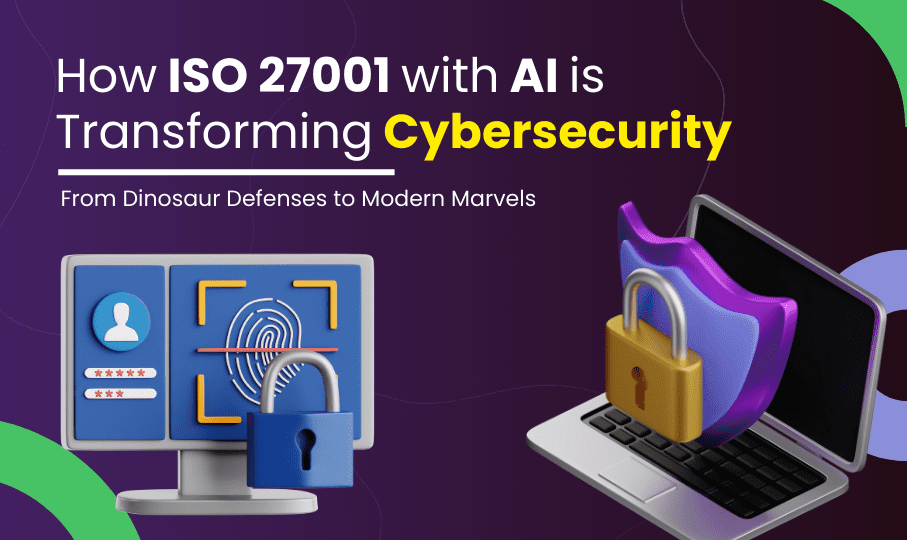Ladies and gents, gather around your screens and keyboards as we take a trip down memory lane, back to a time when cybersecurity was about as effective as using a colander to carry water. Fast forward to today, and we’ve got artificial intelligence (AI) transforming the game, making our old methods look like relics from the Jurassic period.
Let’s explore how ISO 27001 and AI have revolutionized cybersecurity, turning it into a sleek, smart, and proactive force to be reckoned with. And know how much the iso 27001 certification cost to learn and improve skill.
The Prehistoric Era of Cybersecurity: Clunky and Reactive
Remember the early 2000s? We were all excited about our new flip phones and the advent of social media, but when it came to cybersecurity, things were pretty rudimentary. Firewalls and antivirus software were our main defenses.
These tools were about as flexible as a concrete slab, relying heavily on static rules and signature-based detection. This meant they could only recognize threats they’d seen before.
Anything new? Well, that was like showing a dinosaur a spaceship—completely beyond their comprehension.
Enter ISO 27001: A Game Changer in Cybersecurity Standards
ISO 27001, the international standard for information security management systems (ISMS), introduced a structured framework for managing sensitive company information. It was a significant step forward, helping organizations systematically secure their data and processes.
However, even ISO 27001 needed a boost to keep up with the ever-evolving threat landscape.
AI Enters the Scene: The New Age of Cyber Defenders
Enter artificial intelligence, the superhero of modern cybersecurity. AI complements ISO 27001 by not just reacting to threats but also anticipating, learning, and adapting to them.
It’s like having a team of cyber defenders who are not only vigilant but also get smarter with every threat they encounter.
1.Enhanced Threat Detection and Response
Back in the day, threat detection was slow and cumbersome. Security teams had to sift through endless logs and alerts, hoping to catch something amiss. AI changes the game entirely. With machine learning algorithms, AI can analyze vast amounts of data in real-time, identifying patterns that might indicate a threat.
It’s like having a digital Sherlock Holmes on your team, deducing potential cyber attacks before they happen. When integrated with ISO 27001 processes, this proactive approach ensures compliance and robust security.
2.Reduced False Positives
One of the biggest headaches of traditional cybersecurity was the flood of false positives. Every minor anomaly set off alarms, leading to alert fatigue and wasted resources.
AI drastically reduces these false alarms by learning what constitutes normal behavior for a network and flagging only genuine threats. It’s like upgrading from a smoke detector that goes off every time you toast bread to one that only sounds when there’s an actual fire.
This efficiency aligns perfectly with ISO 27001’s requirement for effective and efficient security measures.
3.Automated Incident Response
Back in the pre-AI era, responding to a cyber attack was a manual, time-consuming process. Security teams had to identify the threat, determine the scope, and manually implement countermeasures.
AI automates much of this process. Upon detecting a threat, AI systems can isolate affected areas, block malicious activities, and even start recovery procedures—all in a fraction of the time it would take a human.
It’s like having an automated fire suppression system that kicks in the moment a spark is detected. This automation helps organizations meet ISO 27001’s requirements for rapid and effective incident response.
4.Continuous Learning and Adaptation
Cyber threats evolve at a dizzying pace. Traditional systems needed regular updates and patches, often lagging behind the latest threats. AI, however, continuously learns from new data and threats, adapting its defenses in real-time.
It’s like having a security guard who goes to training every single day, constantly improving their skills. This continuous improvement is a core principle of ISO 27001, ensuring that security measures evolve with emerging threats.
5.Efficient Resource Allocation
Before AI, cybersecurity professionals spent a significant amount of their time on mundane, repetitive tasks—monitoring logs, updating systems, and responding to false alarms. With AI taking over these duties, human experts can focus on more strategic tasks.
This not only improves efficiency but also helps in retaining top talent, as professionals can now engage in more challenging and rewarding work. This efficient resource allocation supports ISO 27001’s objective of optimizing security management processes.
The Future is Now!
In the world of cybersecurity, sticking to old methods is like using a floppy disk in the age of cloud computing—utterly ineffective. AI has revolutionized cybersecurity, providing enhanced threat detection, reducing false positives, automating responses, continuously learning, and optimizing resource use. Also learn cyber security training for beginners to improve your skill.
When combined with ISO 27001, AI doesn’t just upgrade our defenses; it fundamentally transforms how we protect our digital assets. So, let’s embrace our AI Avengers and march confidently into a future where our data is safer, our systems are smarter, and our cybersecurity strategies are more robust than ever.

